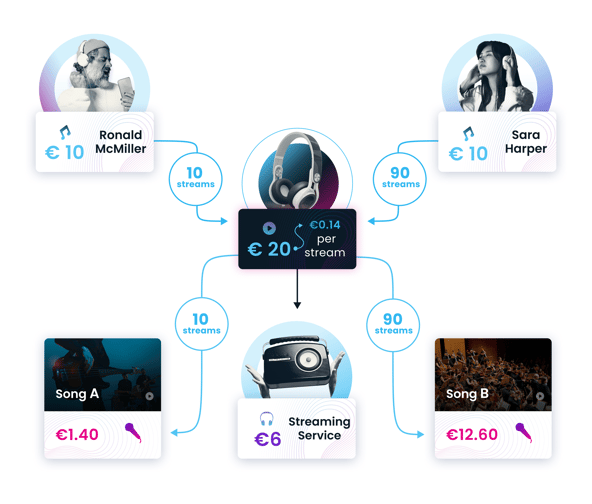How do streaming platforms distribute royalties to music rights holders?
Pro-rata vs. user-centric models, a comparative analysis
As an investor in music catalogues you may already have wondered: “How do artists earn from music streaming platforms? How does the money flow before music rights holders get paid?” .
The royalty payment model adopted by music DSPs (Digital Service Providers) is a hot topic in the music industry. It plays a central part in one of the biggest debates around fair remuneration for streaming music, with a part of the industry experts and professionals demanding for a revision of the current model.
In this article we are going to perform a comparative analysis of the currently predominant pro-rata model and the main alternative user-centric model, to highlight their functioning and relative differences. As the main information source we’re using the paper written by Pedersen Rasmus Rex “A meta study of user-centric distribution from music streaming” (2020), one of the most comprehensive researches on this topic.
The Pro-Rata Model
The predominant royalty distribution model adopted by music DSPs is the so-called pro-rata model. Will Page (former chief economist at Spotify) defined the pro-rata model as a system that “aggregates all consumption and spending from a country’s subscriber population and distributes royalties to rights holders “pro-rata” to their streams”.
In other words, to calculate the royalties that are due to a specific rights holder, DSPs determine the split-share of all registered streams generated in a specific country and month for a certain rights holder and assign the rights holder the resulting percentage of the streaming service’s net distributable revenues for that country.
Sounds complicated, right? Let’s look at it through a simplified example provided in Pedersen R.R. 's report, it will make everything more clear! Let’s assume a hypothetical streaming service consisting of only two subscribers - each paying €10 per month - and two tracks, both from two different music rights holders.

We can consider the pro-rata model as a shared pool where all the revenues coming from one price tier are collected. The streaming service themselves take approximately 30% from the shared pool to cover their overhead costs. The remaining revenue is then allocated to specific rights holders, according to their share of the total streams for that specific month and country. This process gets done separately for each price tier (individual, student, family plan, etc.) of the streaming service .
This model was originally preferred as it allowed for lighter data processing in terms of royalty’ calculation and it was already utilised for advertising. With this reasoning in mind, the model was initially adapted for the freemium music streaming, which was launched prior to the release of premium versions and is also dominantly ad-funded.
Throughout the years the model has been criticised because it leads to cross-subsidisation of heavy listeners, meaning that the heavy users' listening practices strongly influence the payment model. In the example, even though User 1 never listened to track B, most of its subscription fee goes to the rights holders behind that track, and only marginally to the ones behind the track User 1 really listened to.
User-Centric Model
The user centric model represents the main alternative to the pro-rata model: the revenue generated by each individual user (deriving from subscriptions) is distributed to the rights holders according to the share of that specific user’s music consumption. Therefore, differently from the pro-rata model, this model works on an individual-user level rather than on a country's population. The revenue from the users’ subscription is distributed only to the rights holders of the songs the user specifically listened at.
Following the same hypothetical example proposed in Pederson RR's report , the mechanisms underlying the user-centric model can be illustrated as follows:
.png?width=590&height=603&name=Frame%2033200%20(1).png) In this case there is no shared pool of revenue: the money paid by each single user for the subscription (after deducting the 30% that music streaming services keep to cover their overhead costs) is allocated exclusively to the rights holders of tracks that the user listened to.
In this case there is no shared pool of revenue: the money paid by each single user for the subscription (after deducting the 30% that music streaming services keep to cover their overhead costs) is allocated exclusively to the rights holders of tracks that the user listened to.
When this model gets adopted, differently from the pro-rata model, there is no cross-subsidisation of heavy users, and the “pay per stream” varies depending on how many streams the user has generated over a certain period.
Some players in the music industry already implemented - or at least partially- user-centric royalty distribution models. Some examples are:
- TIDAL - Direct Artist Payout: which sees a percentage of the HiFi Plus subscribers’ membership fees directed towards the users’ top streamed artists.
- Soundcloud - Fan-powered royalties
- Deezer - User Centric Payment System (UCPS)
Final considerations
After having discussed the mechanics for each model and their differences, two final remarks should be highlighted to have a complete understanding of the topic:
- Who is paid: "Music streaming services usually do not pay artists directly. In most cases, they pay the artist’s record labels, publishers, distributors or collecting societies which then pay the artists according to their individual agreements. Therefore, streaming services usually have little to no knowledge on the agreements and how the earnings are split between the artists, the labels or publishers and all the other collaborators.
-
Pay-per-stream: despite the ease of this metric, music streaming services do not pay artist royalties according to a per-play or per-stream rate. The royalty payments that artists receive might vary according to differences in how and where their music is streamed or the agreements they have with labels or distributors.
We hope the above gives you a clear overview on how everything works. At ANote Music we thrive to give our investors a full understanding of the dynamics underlying the royalty distribution, as royalties play a key role in our ecosystem.
Looking to learn more about ANote Music? Go visit the ANote Music platform, create an account or log in, and discover all financial details and relevant insights about our listed music catalogues. Click here to visit the platform.
Stay tuned!
ANote Music



